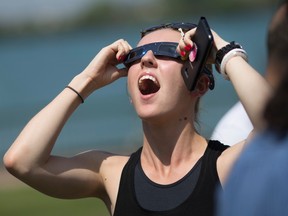
Article content
By: Gordon Drake
Imagine being there in ancient Miletus when the Greek philosopher Thales commanded the sun to disappear.
Article content
It was recorded that he amazed his followers — and even more so when a few minutes later he commanded it to come back again!
Thales, the first of the ancient Greek philosophers whose name history records, may have learned his secret of predicting solar eclipses from ancient Egyptian astronomers. The secret gave astronomers great power over their followers who believed it was magic.
Advertisement 2
Article content
Residents of Essex County and Windsor will soon also have the opportunity to follow in Thales’ magic footsteps with a rare opportunity to witness a total or partial eclipse of the sun.
This spectacular celestial event occurs locally between 1:58 p.m. and 4:27 p.m. on Monday, April 8, with totality reached at 3:14 pm. The eclipse will be only partial in Windsor, but for those observing on a narrow strip along the north shore of Lake Erie, it could total up to two or more minutes.
In a solar eclipse, the shadow of the moon sweeps across the surface of the Earth as the moon passes between us and the sun. All those standing within the shadow will see the eclipse. As you look up, what you see is the moon completely covering the sun.
Solar eclipses occur about once every 18 months, but the shadow is so narrow that very few are lucky enough to be in that shadow. A solar eclipse is unlike a lunar eclipse. A lunar eclipse is visible to everyone on Earth, since we all see the shadow of the Earth on the same moon.
To make your own “eclipse,” take the shade off a lamp and look at the bright bare lightbulb. Now place your fist at arms length in front of your eyes so that your fist covers the bulb. That is your own small eclipse, with your fist playing the role of the moon, and the bulb the sun.
Advertisement 3
Article content
So what is special about a solar eclipse?
During a solar eclipse, the sky becomes so dark that stars come out and birds get ready for sleep.
You also may have the rare opportunity of seeing the solar corona. That is the ring of hot ionized gas that is the outer atmosphere of the sun. Normally, it is not visible since the surface of the sun itself (known as the photo sphere) is about a million times brighter, and so it overwhelms the much fainter corona.
You may also see red prominences and/or flares. These are projections of hot gases into the lower atmosphere of the sun, and are visible around the rim of the moon as it covers the sun. The corona and prominences are rare phenomena that can only be seen during a total eclipse, so don’t miss this remarkable opportunity on April 8.
An important word of caution:
Special dark glasses are essential to view the eclipse, but you can safely take them off during the brief period of totality. This is also a wonderful opportunity to take rare photographs that capture the sun’s corona during totality.
Thales was not the only astronomer to observe solar eclipses of great historical significance. English explorer Captain James Cook measured the distance across the Atlantic Ocean by observing the solar eclipse of Aug. 5, 1776, in Newfoundland.
Advertisement 4
Article content
Astronomers in Oxford, England, observed the same eclipse, and from the time
difference they were able to make the first accurate calculation of the distance across the Atlantic Ocean between these two observation points.
Then, on May 29, 1919, on Principe Island off the west coast of Africa, Sir Arthur Eddington observed the solar eclipse as a test of Albert Einstein’s General Theory of Relativity. He observed a shift in the apparent position of stars near the eclipsed sun as predicted by Einstein’s theory of relativity. This success brought the then-relatively unknown Einstein such immediate worldwide fame that the theoretical physicist’s name eventually became a household word synonymous with brilliance and spectacular science.
Most people never see a total eclipse of the sun in their entire lives. Others make a hobby out of chasing eclipses around the world.
So don’t miss this rare opportunity to see a total or partial solar eclipse in your own backyard.
But remember: do not look directly at the sun without protective glasses.
Gordon Drake is a Physics Professor Emeritus, University of Windsor;
past principal of Canterbury College, and past president of the Canadian
Association of Physicists.
Article content



